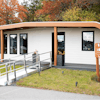Everything is big in Texas, but when it comes to hospitals, the Texas Medical Center in Houston is the biggest in the world. Laid out over an area more than 50 percent larger than New York’s Central Park, this massive healthcare complex sees more than 7 million patients every year and its doctors complete nearly a 1,000 surgeries per day. “There’s no collection like this anywhere in the world,” says TMC’s President Robert C. Robbins.
But size hasn’t been Dr. Robbins’ only challenge. For years, big power plant owners and Texas community groups have been raising alarms about the possibility rolling blackouts, and urging the state to overhaul its power markets and add capacity to the grid.
In 2009, TMC and its partner, the Thermal Energy Corp. (TECO), decided to take matters in their own hands and use a seemingly unusual technology to generate backup electricity as well as heating and cooling for the hospital complex: a modified jet engine, the same kind that powers many Boeing 747s, including Air Force One. Jeff Immelt, GE chairman and CEO calls this transfer of know-how from one GE business to another “the GE store.”
The bet has been paying off. TMC has had reliable air conditioning, heat and backup power for nearly five years now, and this week the U.S. Environmental Protection Agency awarded TECO its prestigious ENERGY STAR CHP Award.
The award is basically a seal of approval like the one you see on refrigerators and microwaves, only much larger. The ENERGY STAR CHP Award is given to combined heat and power projects that are the best of its kind in the United States. TECO took home the prize the first year it was eligible to compete.
The machine that TECO has been using since 2011 didn’t have to travel far. It was assembled at a plant just south of the city that belongs to GE’s Distributed Power business.
Because of their jet engine heritage, GE calls the machines “aeroderivative” gas turbines. The one working at TECO can generate 48 megawatts of electricity and also supply the hospital with steam and hot water to make sure the center stays cool in the summer and warm in the winter. “We serve over 6,500 hospital beds,“ says Steve Swinson, president and CEO of TECO. “If we don’t do what we do, they don’t do what they do.”
GE engineers built the TECO’s LM6000 aeroderivative turbine around the CF6-80 jet engine, one of the world’s first high-bypass turbofan jet engines.
Just like a plane gunning its engines for takeoff, aeroderivative turbines can ramp up to full power in less than 10 minutes. This makes them handy during blackouts, when they need to quickly pickup slack, and also in the hot summer when everyone flips on the AC and electricity demand surges.
Aeroderivatives’ sturdy and compact design also allowed GE to put them on trailer and dispatch them wherever power is quickly needed. Princeton University used the technology to keep the campus lit and warm while the surrounding town went dark during Hurricane Sandy, and the generator sets – known as TM2500s - are also generating electricity on the edge of the Sahara in Algeria and in Egypt.
Besides providing reliable power, the turbine also allows TECO to cut enough carbon dioxide emissions by more that 32,000 tons per year, the equivalent of removing 4,000 cars from the road.
Not bad for a grounded aircraft engine.






















